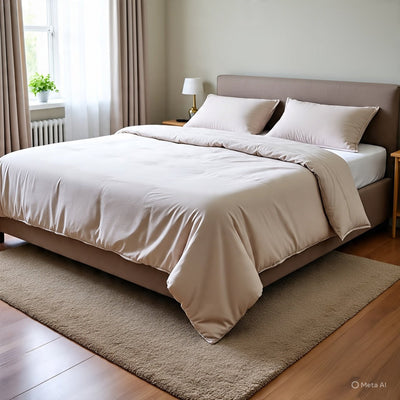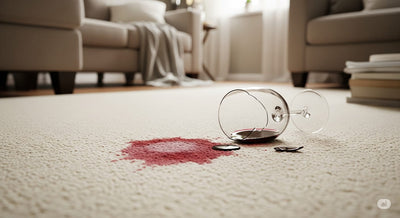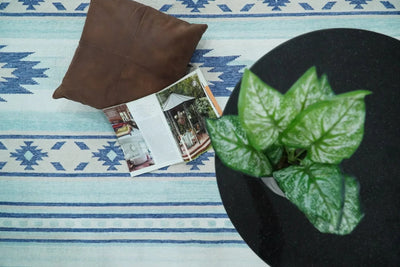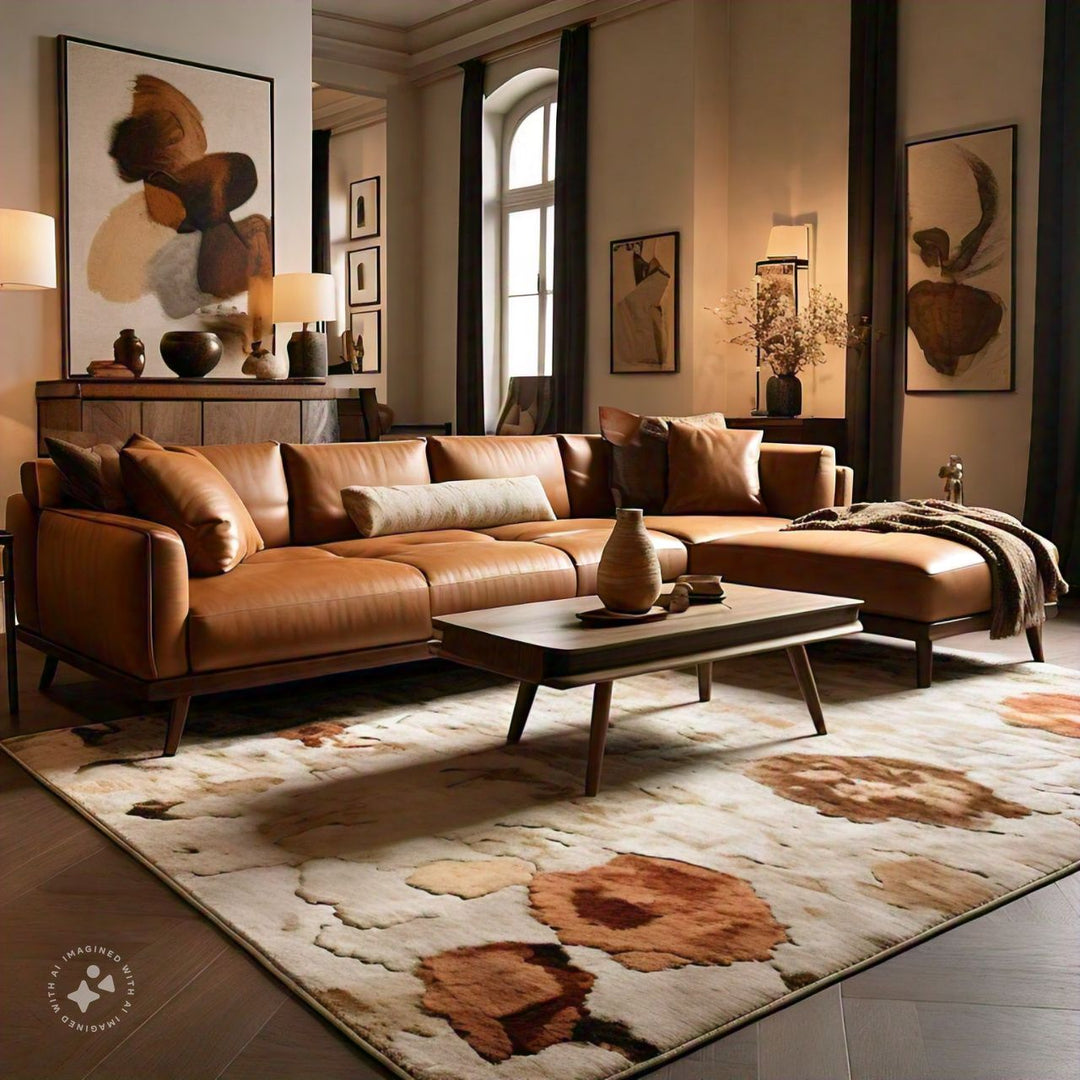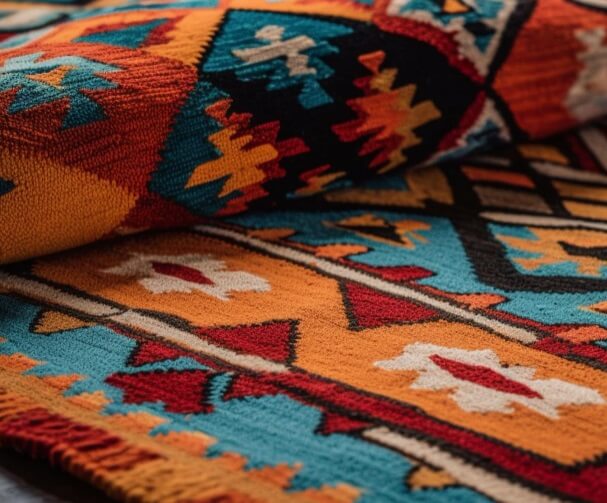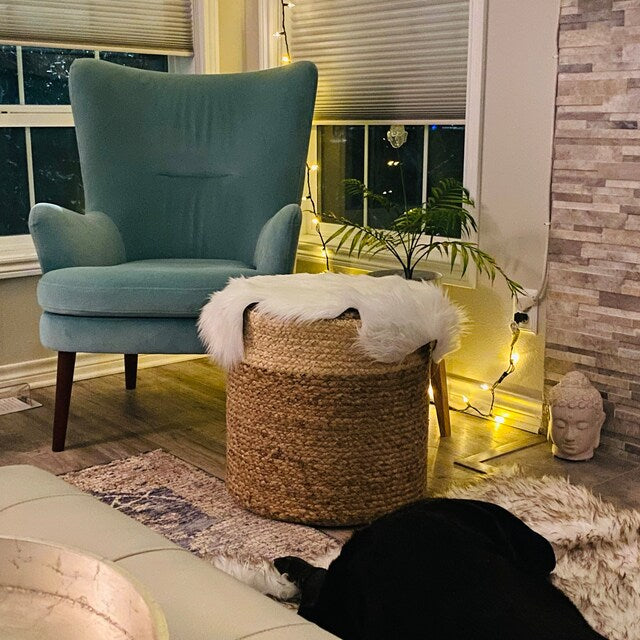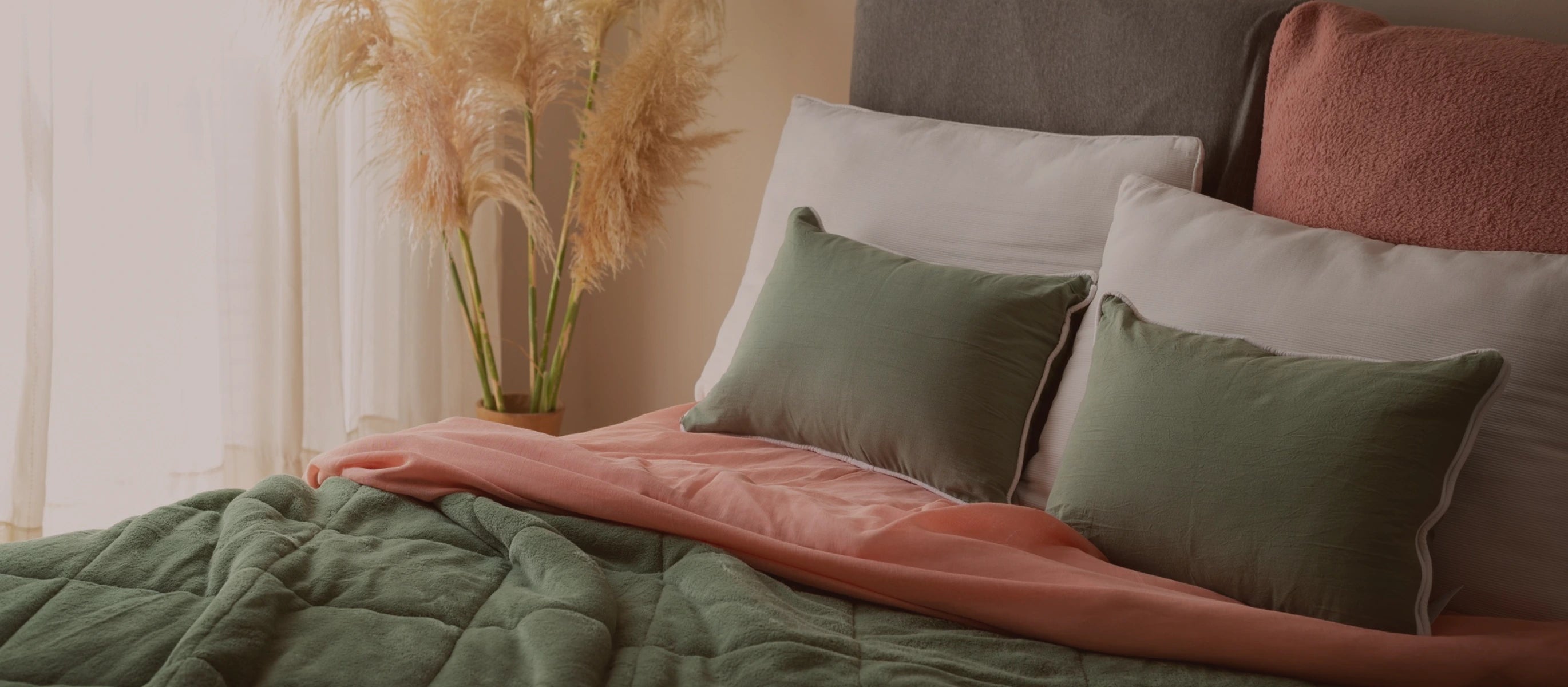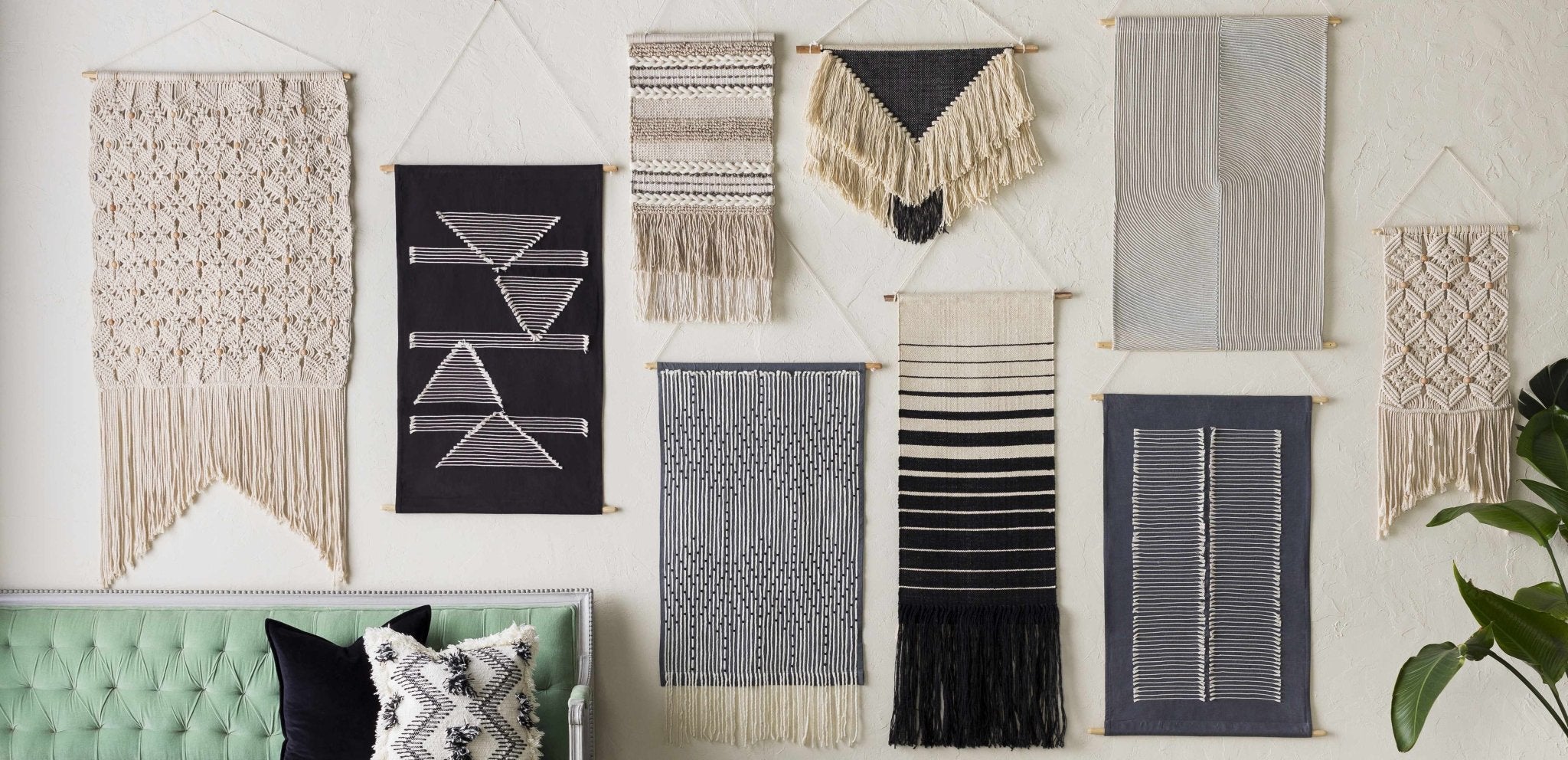All About Oushak Rugs- History, Designs, Origin
You may be familiar with the term Ushak or Oushak carpets. The design of an antique Oushak rug is influenced by Persian culture and Turkish tradition. They add a sense of quiet and tranquility to the space and are ornate and lovely with their large-scale flower designs and motifs.
A perfect example of fusing ancient history with contemporary design for a finished aesthetic effect is seen in Oushak carpets. Read until the end to know an Oushak rug's history, weaving, features, caring tips, and more.
What are an Oushak rug and its history?
Weaved in Western Turkey, Oushak rugs—also called ushak rugs—have distinctive patterns like angular, broad floral patterns. They typically create a calm and pleasant atmosphere in a space. Despite having a modern appearance and feel, an antique Oushak rug is still made today with the same aesthetic as its archetypal forebears.
An antique Oushak rug was first produced in a locality that would later take the name of the rug and Oushak has been the hub of considerable Turkish rug manufacturing since the 15th century. Europeans started purchasing rugs and carpets from producers in the 17th century.
Anthropologists began studying the carpets and rugs in Istanbul's bigger mosques, such as the Sultan Ahmet Mosque, some 40 years ago. Nearly all of the floor coverings that the scientists discovered on the mosque floors, which were frequently six or seven deep, were from the region around Oushak.
Learn more about terms related to Oushak rugs on our rug glossary page.
How Oushak rugs became popular in the West?
The antique Oushak rug design is a favorite among many home designers and decorators in the United States and abroad. They include larger-than-life motifs, adobe-like shapes, and subdued hues, giving them a simpler, softer appearance.
They are more in line with the style that has dominated design for the last few decades in both the United States and Europe, particularly in Europe, where it has been the standard for much longer.
While the 17th and 18th centuries saw a brief shift in the European market's preferred aesthetic toward the more complex and centralized designs of the French Aubusson and Savonnerie carpets. However, the simpler patterns, colors, and laid-back look of the antique Turkish Oushak rugs never left the European psyche. They later made a comeback in the 19th century in an even more subdued variation that was increasingly in demand by the rising elite ranks.
The traditional colors and centered patterns that were once popular with the European elite fell out of vogue in Persia, the other major region for weaving oriental rugs. The demand for Turkish-style rugs dominated the weavers' taste.
The interior design industry in the West continues to be very fond of these vintage Turkish Oushak carpets and their contemporary Persian counterparts. As a result, they are often referred to as "decorative rugs," as this is the design that the interior decor community feels is the most appropriate for their client's requirements.
Below is our best-selling Oushak Rug -
Characteristics of Oushak rugs
Materials
Cotton, wool, silk, and even metal threads are the materials used in Oushak. The primary foundation of an antique Oushak rug is made of cotton, and the pile is made of wool. For hand-knotted rugs, quality is everything. The base for the rugs was constructed using fine wool. The raw material was also transformed into hand-spun wool that was later colored using natural plant and vegetable dyes. Once this was done, the carpet designs were created by weaving the wool.
Colors and Designs
An Oushak carpet is recognizable. Most of them have a background that either makes it a dark ivory Oushak rug or light gold one, with florals and angular shapes in the foreground. The hues in these rugs were derived from natural vegetable dyes, including smokey saffron, blazing terracotta, deep blues, brilliant apricots, and rich cinnamon. The wool itself has a silky, smooth, and luminescent appearance. However, some commercially made Oushak carpets have been discovered.
Knotting techniques
The Ghiordes knot is the primary knot used to make these rugs. This one is loose compared to other knots, including the conventional Turkish and Persian ones. The density of an antique Oushak rug is important to consider when purchasing. You should have a basic understanding of the knotting technique used to create these carpets to choose the right one for your home.
If the rug seems light or flimsy to you, the knots are loose. This will also weaken and degrade the rug over time, causing it to fall apart. When the knots are 'packed down' with a tool that resembles a comb, sturdy Oushak rugs are produced. By doing this, the hand-knotted carpet will remain stable and durable.
Customers should be aware that the rug's density is crucial. The way the rug maker binds the knots is important. The rug will appear flimsy if the knots he ties are loose. The rug will be less resilient if the ties are loose. An essential step in this procedure is to pack the knots down with an implement called a punja.
Features and patterns of Oushak rugs
Fine wool carpets
Handmade Oushak rugs are created to last for many years without getting ruined. These carpets are more resistant to tearing and pressure than their contemporary equivalents since they are made of high-density wool. The best-handcrafted rugs available are Oushak wool ones, which is the ideal choice. Wool also has the benefits of being gentle, water-resistant, and cleanable.
Wide range of designs
The standard antique Oushak rug will have a bordered pattern with floral motifs and a rustic aesthetic. The floral patterns and range of designs make Oushak rugs popular in contemporary and classic home decor.
Easy maintenance
The fact that Oushak rugs are simple to clean is their best feature. Since most of these carpets are made entirely of cotton, they are simple to care for. Cotton doesn't readily retain stains, so accidents on these rugs can be quickly cleaned up.
Incredibly versatile
These rugs are the best option if you're seeking a handcrafted rug that can be utilized in your living room, bedroom, or any other area of your house. These carpets provide beauty and brightness to any space with soft, natural designs.
Additionally, they are made in lighter hues that go with most decor styles. Look no further than a fine Oushak Rug if you want a rug that looks equally at home in the living room and the bedroom.
Softer hues
Since darker-colored rugs are simpler to keep clean and maintain, many people like them. Darker hues, on the other hand, can drain the light from a height setting and make rooms appear smaller. Fortunately, 100% natural wool is used to make Handmade Oushaks, which are also simple to clean.
They are also available in various lighter hues like beige, off-white, light brown, and light blue. Many of these carpets look fantastic in spaces with contemporary decor and are ideal for contrasting dark-colored furniture. The lighter color tones also give spaces a pleasant, cozy atmosphere and make them appear larger.
Soft texture
Compared to many other handmade rugs, including Baluchi and Kilim Rugs, Oushak Rugs have a higher pile and are considerably softer. They can withstand heavy foot traffic and won't lose their pile easily. Get a high-quality Oushak rug today if you're seeking a plush, cozy rug for your house!
Types of Oushak rugs
Medallion Oushak rugs
The first Medallion Oushak rugs appeared in the 16th century. The Turkish masters' authority and creative prowess are showcased through the presence of multiple ornate medallions on Oushak carpets. Be careful not to translate the book's art to the carpet, these masters.
A sizable medallion is present in the carpet's center, while quarter medallions are in the corners. Plant ornaments and small art compositions with human and animal creatures are placed inside the medallions and along the carpet's base. Furthermore, the central axis medallion symbolizes infinity.
Antique Oushak rugs
In the former Ottoman Empire in the 15th century, Oushak (or Ushak) carpets were knotted with fine, lustrous wool in soft, brilliant hues. Usak was the name of the city they came from.
Modern carpets faithfully imitate the larger, more open botanical, medallion, or angular pattern features in antique Oushak rugs. The color scheme includes watery blues, flowery greens, and hues like cinnabar, terracotta, sand, and gray Oushak rug.
Due to the use of premium wool in their creation, antique Oushak rugs are frequently distinguished by relatively loose knots and long heaps.
Turkish Oushak rugs
Turkish Oushak rugs are among the most exquisite and distinctive rugs in existence. Nevertheless, prices might vary greatly depending on where you buy them. Check out The Rug Decor's selection if you're seeking an affordable choice.
Because the Turkish knot is one of their distinctive qualities, oushak rugs are occasionally referred to as Turkish carpets. In contrast to the Persian (or Senneh) knot, this knot is known as the Ghiordes knot in Turkish. Most Persian rugs, as well as many carpets created by hand in Afghanistan, China, Pakistan, and India, use the Persian knot, an asymmetrical double knot.
Vintage Oushak rugs
While rugs older than 80–100 years are regarded as antique, rugs between 50–80 are referred to as semi–antique, a less well-known category. Although any rug 20 years old or older can be categorized as vintage, the consensus is that the term only pertains to 20 to 50 years old. Therefore, older than two decades-old rugs fall under the vintage Oushak rugs category. However, the patterns, designs, and colors are almost identical to the antique ones.
Modern Oushak rugs
A rug with Turisk origins from Usak, Turkey, and distinctive pattern elements is known as an Oushak rug. They frequently have elaborate patterns with a strong Persian influence. The bedroom in your home is begging for one of the more modern Oushak rugs, which typically come in a rainbow of pastel colors and softer textures too!
How to identify authentic Oushak rugs?
Here's how to determine if you have an actual antique Oushak rug in your possession:
- If you purchase the rug from a reputable carpet merchant such as The Rug Decor, you can bring it home and give it a test run. You should get it if it looks well in the room and adds a bit of tradition and luxury.
- It will feel dense and weighty, indicating numerous knots in it.
- Look at the layout. Identifiable floral motifs with smaller vines and medallions trailing to the sides may be found on most Oushak rugs. The flower is frequently combined with geometric patterns, demonstrating the union of tradition and modernism.
- Inquire about the color or dye used in the rug. You should choose the one colored with a natural or vegetable dye, if possible. Chemically colored rugs are not as appealing and are not even authentic.
Care and maintenance of Oushak rugs
Limited sun exposure
The pile of Oushak rugs is exceptionally dense making it vulnerable to damage from direct sunlight. So, Oushak rugs will fade in direct sunshine, even when rolled up or folded. Therefore, if you have an antique Oushak rug, keep it away from places it might be exposed to sunlight, or at least put a curtain between it and any neighboring windows.
Heavy objects
Putting heavy items on top of the Oushak Rug should be avoided. The surface of your Oushak rug may get permanently creased if heavy objects are placed on top of it. To protect your Oushak rug, avoiding putting anything heavy on top of it is best.
Maintain cleanliness
You should clean them frequently since if you leave them alone, dust and debris will eventually accumulate in their delicate knots. Every three months, vacuum and wash your carpets to prevent dust from building up on their lovely designs. When cleaning them, avoid using hot water and bleach to prevent the color from fading.
Regular vacuuming
Oushak rugs are precious possessions, and ensuring their longevity is important. Maintaining your rug's cleanliness by routinely vacuuming is one way to achieve this. At the absolute least, try vacuuming it every three days. This way, you can prevent dirt from having as much time to absorb into the fibers of your rug and keep it cleaner than if you only vacuum once a week or never. Consider doing it more frequently if you have children, pets, allergies, or if your home is dusty.
Wash them properly
Your Oushak rugs will last longer if you take care of them. Always wash when necessary. Avoiding it continuously and allowing dirt and grime to accumulate is pointless. To prevent damage, please carefully follow these directions when washing it. You want to ensure that your Oushak rug is fully clean and free of any soap residue from excessive washing or soap Oushak.
Stain removal
To avoid stains, keep your carpets clear of high-traffic areas and clean them frequently. If you have kids or pets, you should lay down a runner first. Regularly vacuum with a gentle brush attachment, and occasionally turn your Oushak rug. Use a cloth to absorb any extra liquid, then rinse with water, preferably cold, while giving the area a light scrape. Instead of cleaning your entire carpet, applying soap directly to spots is preferable. Before allowing anyone back on it, let it completely dry.
Keep away from humidity
Avoid choosing an Oushak rug carpet near a bathroom or in a moist space while shopping for one. The moisture from these locations will readily destroy your vibrant Oushak rugs. If you already own an Oushak rug, keep moisture zones away from it by putting it in a room with plenty of natural light or, ideally, outdoors of your house. You can use water, a light soap, or detergent to wash your Oushak rug, but never put it in a washing machine since excessive agitation during the spin cycle could cause damage or destruction.
FAQs
How to incorporate antique Oushak rugs into your home décor?
Oushak rugs are no less than premium works of art that bring sophistication and style to your home, irrespective of where you place them. However, it is best to choose colors and patterns that match the room's existing décor for the most refined look.
What is the difference between Oushak and Turkish rugs?
There is no difference between Oushak and Turkish rugs because Oushak rugs are just a sub-c+ategory of the latter. Considered one of the best types of Oriental rugs, Oushak weaving started in the Anatolia region of Turkey.
How can I tell if my Oushak rug is an antique?
The best way to identify the authenticity of an antique Oushak rug is by checking its label, which should mention the year and place of origin. Ensure that the place is not anywhere other than Turkey and the year is not after 1968.
Are Oushak rugs suitable for high-traffic areas?
Oushak rugs are comparatively softer in texture and are also more premium. That's why it is not the best idea to place it in very high-traffic areas. However, with regular maintenance, it can endure low to moderate pressure easily.
Are Oushak rugs good quality?
Yes, Oushak rugs are made of top-quality materials, and the overall texture is incredibly soft and comfortable. Moreover, maintenance of Oushak rugs is also comparatively easier, and the usage of wool makes it durable too.
Where to buy Oushak rugs?
Choosing the right store to purchase premium rugs, such as the Oushak ones, is very important. The Rug Decor is an ideal destination for all your rug requirements considering the wide range of products, quality assurance, and price.
Why are Oushak rugs so expensive?
An antique Oushak rug is made of the finest materials, completely hand-knotted, and dyed manually using natural dyes, so the effort and time required are greater. That's why the price of Oushak rugs is on the higher end.
Check out our hand-knotted oushak rug collection
